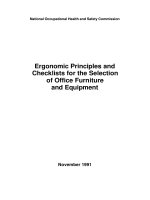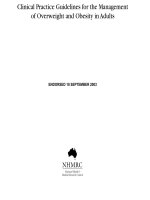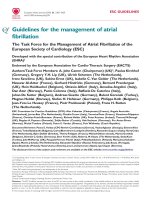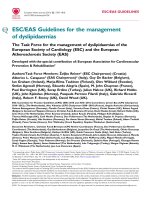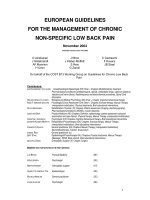In-vitro efficacy of fungicides and bioagents for the management of soft rot of ginger caused by pythium aphanidermatum
Bạn đang xem bản rút gọn của tài liệu. Xem và tải ngay bản đầy đủ của tài liệu tại đây (415.32 KB, 9 trang )
Int.J.Curr.Microbiol.App.Sci (2019) 8(9): 3007-3015
International Journal of Current Microbiology and Applied Sciences
ISSN: 2319-7706 Volume 8 Number 09 (2019)
Journal homepage:
Original Research Article
/>
In-Vitro Efficacy of Fungicides and Bioagents for the Management of Soft
Rot of Ginger Caused by Pythium aphanidermatum
J. Chaithra1*, Sunil Kulkarni1, Gururaj Sunkad1, Y. S. Amresh1 and Shekhar Patil2
1
Department of Plant Pathology, 2Department of Horticulture, University of Agricultural
Sciences, Raichur-584100, India
*Corresponding author
ABSTRACT
Keywords
P. aphanidermatum,
non systemic,
systemic,
combifungicides,
bioagents.
Article Info
Accepted:
20 August 2019
Available Online:
10 September 2019
Ginger soft rot caused by Pythium aphanidermatum is the most destructive
and widespread fungal disease of ginger. It has drastic effect on yield
causing upto 50% loss under favorable conditions. In vitro experiment was
conducted for selection of superior fungicides for the management of
ginger soft rot. Different non systemic, systemic and combi fungicides were
evaluated against the Pythium aphanidermatum pathogen in in-vitro
condition with three different concentrations, among non systemic
fungicides, Mancozeb found best effective fungicide which shows 100 per
cent inhibition of fungus growth at all three concentrations,. In systamic
fungicides, the Carbendazim exhibited 100% fungal growth inhibition at all
three concentration. Among six different combifungicides were evaluated,
Carbendazim 12% + Mancozeb 63% WP and Metalaxyl M 8%+ Mancozeb
64% WG showed the maximum inhibition (100 %, 100 % and 100 %) of
the test fungus at all the three concentrations (0.1, 0.2 and 0.3 %)
respectively. Among the bio agents tested aginst P. aphanidermatum, T.
harzianum (Th-4) inhibited maximum mycelia growth of the test fungus
(70.40 %).
Introduction
Ginger (Zingiber officinale Rose) is one of the
most important spices crops in India. It is
grown throughout the country. In northern part
of the country, the farmers cultivate it as a
cash crop. Ginger has special significance for
tropical countries, where it is produced and
consumed in large quantities (Burkill, 1966
and Purseglove et al., 1981). It has medicinal
value too. At present ginger is also being used
for chewing purpose. In India, ginger is
cultivated with an area of 1,68,000 ha, with
the production of 10,76,000 MT and
productivity of 6.4 MT/ha (Anonymous, 201718).
3007
Int.J.Curr.Microbiol.App.Sci (2019) 8(9): 3007-3015
Materials and Methods
In-vitro evaluation of fungicides
Efficacy of seven non systemic fungicides,
eight systemic and six combi fungicides was
evaluated in vitro at various concentrations
against
P.
aphanidermatum,
applying
Poisoned food technique (Nene and Thapliyal,
1993) and using Potato dextrose agar (PDA)
as basal culture medium.
Based on active ingredient, requisite quantity
of the test fungicides was calculated, mixed
separately thoroughly with autoclaved and
cooled (40 oC) PDA medium in conical flasks
to obtain desired concentrations. This PDA
medium amended separately with the test
fungicides was then poured (20 ml / plate)
aseptically in Petri plates (90 mm dia.) and
allowed to solidify at room temperature. For
each of the test fungicide and its desired
concentrations, three plates / treatment /
replication were maintained.
After solidification of the PDA medium, all
the plates were inoculated aseptically by
placing in the centre a 5 mm culture disc
obtained from actively growing 7 days old
pure culture of P. aphanidermatum and
incubated in an inverted position at 28 ± 2 oC.
Petri plates filled with plain PDA (without any
fungicide) and inoculated with the pure culture
disc of P. aphanidermatum were maintained
as untreated control.
Observations on radial mycelial growth /
colony diameter were recorded at an interval
of 24 hours and continued till untreated
control plates were fully covered with
mycelial growth of the test pathogen. Per cent
inhibition of the test pathogen with the test
fungicides over untreated control was
calculated by applying following formula
(Vincent, 1927).
Where I= Per cent inhibition
C= Growth of fungal plant pathogens in
control (mm)
T= Growth of fungal plant pathogens in
treatment (mm)
In vitro evaluation of bioagents
Different fungal and bacterial bioagents were
evaluated in vitro against P. aphanidermatum,
applying Dual Culture Technique (Dennis and
Webster, 1971). Seven days old cultures of the
test bioagents and test pathogen (P.
aphanidermatum) grown on PDA were used
for the study.
Two 5 mm culture discs, one each of the test
pathogen and test bioagents were cut out with
sterilized cork borer and placed at
equidistance, exactly opposite to each other on
autoclaved and solidified PDA medium in
Petri plates and three plates were incubated at
27 ± 2 oC. PDA plates inoculated alone with
pure culture disc (5 mm) of the test pathogen
were maintained as untreated control.
The experiment is designed in CRD and all
treatments replicated thrice. Observations on
linear mycelial growth of the test pathogen
and test bioagent were recorded when
untreated control plates were fully covered
with mycelial growth of the test pathogen.
Per cent inhibition of the test pathogen with
the test bioagent, over untreated control by
using the formula given below by Vincent
(1947).
3008
Int.J.Curr.Microbiol.App.Sci (2019) 8(9): 3007-3015
Where,
I = Per cent inhibition
C = Growth of fungal plant pathogens in
control (mm)
T = Growth of fungal plant pathogens in
treatment (mm)
turmeric. Mancozeb contains dialkine
dithiocarbamate which acts as strong chelating
agent, which binds with the metal bound
protein ions of the fungus hence normal
metabolic function of the fungus gets affected.
In vitro evaluation of systemic fungicides
Results and Discussion
In vitro evaluation
fungicides
of
non
systemic
The studies on in vitro evaluation of
fungicides against P. aphanidermatum,
revealed that the most effective fungicides was
mancozeb, with a mean inhibition of fungal
growth of 100 per cent. While cuprous oxide
(29.57) was found to be least effective
fungicide.
The next best fungicide was captan, which
exhibited mean inhibition of 92.99 per cent
within the treatments. Highest concentration
(0.3 %) of all fungicides tested significantly
inhibited the fungal growth than lower
concentrations of 0.1 per cent. Mancozeb gave
100 per cent inhibition of growth of test
fungus at all three concentrations tested. The
results are depicted in Table 1 and Fig. 1.
These results very much supported results of
Das et al., (1990). where they studied efficacy
of three different fungicides i.e., Captan,
Captafol, Dithane M-45 (mancozeb) for seed
treatment to control the rhizome rot of ginger.
The captafol treatment at 0.2 % for 30 minutes
was also effective than Captan. Dithane M- 45
(Mancozeb) at 0.3 % was almost as effective
as Captan and Captafol. It was found that,
Captan was more effective against rhizome rot
of ginger.
The Sarma (1994) recommended Dithane M45 was used as seed treatment and soil drench
for controlling the rhizome rot of ginger and
The different of fungicides viz., Fosetyl-Al
(80WP), Carbendazim (50WP), Tridemorph
(75EC), Azoxystrobin (23SC), Tebuconazole
(25EC), Triadimefon (20EC), Hexaconazole
(5EC), Carboxin (75WP) were evaluated for
both P. aphanidermatum and F. oxysporum at
0.05, 0.1 and 0.15 per cent concentrations.
All tested systemic fungicides were capable of
inhibiting the mycelial growth to the extent of
50.00 per cent except fosetyl-al.
In case of P. aphanidermatum results revealed
that carbendazim was resulted 100 per cent
inhibition at all the three concentrations tested
(0.05, 0.1 and 0.15 %) and found significantly
superior over the other fungicides which is on
far with carboxin (88.50 %).
Tebuconazole (68.61 %, 69.78 % and 72.22
%), Hexaconazole (63.35 %, 72.24 % and
74.44 %) were also equally effective and least
inhibition was observed in fosetyl-al (42.14
%) at all the three concentrations was tested
respectively. The results are depicted in Table
2 and Fig. 2.
The results are seen similar with results of
Thakore et al., (1988) evaluated six nonsystemic and four systemic fungicides against
rhizome rot with respective fungicides before
planting. Of these, Mancozeb, Captafol,
Ziride, Captan and Metalaxyl decreased
rhizome rot incidence besides increased
germination and yield. Chawan et al., (2017)
observed that Metalaxyl and Carbendazim
gave cent per cent (100 %) mycelial inhibition
against P. aphanidermatum.
3009
Int.J.Curr.Microbiol.App.Sci (2019) 8(9): 3007-3015
Table.1 Efficacy of non systemic fungicides against P. aphanidermatum
Sl. No.
Fungicides
0.1
100.00*
(90.00)**
Per cent inhibition
Concentration (%)
0.2
0.3
100.00
100.00
(90.00)
(90.00)
Mean
100.00
(90.00)
1
Mancozeb (75WP)
2
Captan (50WP)
85.84
(67.90)
93.14
(74.82)
100
(90.00)
92.99
(74.64)
3
Cuprous oxide (75WP)
26.72
(31.12)
29.07
(32.62)
32.92
(35.01)
29.57
(32.94)
4
Zineb (75WP)
74.73
(59.82)
84.31
(66.66)
100
(90.00)
86.34
(68.30)
5
Copper Oxy Chloride
(50WP)
28.51
(32.27)
38.52
(38.36)
42.09
(40.44)
36.37
(37.09)
6
Chlorothalonil (75WP)
75.94
(60.62)
76.10
(60.73)
83.87
(66.32)
78.63
(62.46)
7
Propineb (70WP)
70.51
(57.10)
75.01
(60.00)
86.88
(68.76)
77.46
(61.65)
66.03
(54.34)
70.87
77.96
(57.33)
(62.00)
S. Em±
0.22
0.13
0.38
Mean
Fungicides (F)
Concentration (C)
F×C
*Mean of three replications
**Values in the parentheses are arc sine transformed
Fig.1 Efficacy of non systemic fungicides against P. aphanidermatum
3010
71.62
(57.80)
C.D. at 1%
0.82
0.50
1.42
Int.J.Curr.Microbiol.App.Sci (2019) 8(9): 3007-3015
Table.2 Efficacy of systemic fungicides against P. aphanidermatum
Sl. No.
Fungicides
1
Fosetyl-Al (80 WP)
2
Carbendazim (50 WP)
3
Tridemorph (75EC)
4
Azoxystrobin (23SC)
5
Tebuconazole (25EC)
6
Triadimefon (20EC)
7
Hexaconazole (5EC)
8
Carboxin (75WP)
Mean
0.05
34.20*
(35.79)**
100.00
(90.00)
59.41
(50.42)
61.83
(51.85)
68.61
(55.93)
76.59
(61.06)
63.35
(52.74)
77.79
(61.88)
67.72
(55.37)
Fungicides (F)
Concentration (C)
F×C
Per cent inhibition
Concentration (%)
0.1
0.15
Mean
40.76
51.47
42.14
(39.67)
(45.84)
(40.44)
100.00
100.00
100.00
(90.00)
(90.00)
(90.00)
64.11
68.24
63.92
(53.20)
(55.70)
(53.11)
67.61
69.81
66.42
(55.31)
(56.67)
(54.61)
69.78
72.22
70.20
(56.65)
(58.19)
(56.92)
82.67
86.21
81.82
(65.41)
(68.21)
(64.89)
72.24
74.44
70.01
(58.20)
(59.63)
(56.86)
87.70
100.00
88.50
(69.47)
(90.00)
(59.91)
73.10
77.78
72.86
(58.75)
(61.87)
(58.60)
S. Em±
C.D. at 1%
0.140
0.54
0.180
0.70
0.312
1.21
*Mean of three replications
**Values in the parentheses are arc sine transformed
Fig.2 Efficacy of systemic fungicides against P. aphanidermatum
3011
Int.J.Curr.Microbiol.App.Sci (2019) 8(9): 3007-3015
Table.3 Efficacy of combi fungicides against P. aphanidermatum
Sl.
No.
Combi fungicides
Per cent inhibition
Concentration (%)
0.1
0.2
0.3
Mean
51.30*
82.96
97.04
77.10
(45.74)** (65.63) (80.13)
(63.83)
1
Captan 70% + Hexaxonazole 5% WP
2
Carbendazim 12% + Mancozeb 63% WP
100.00
(90.00)
100.00 100.00
(90.00) (90.00)
100.00
(90.00)
3
Iprodione 25%+ Carbendazim 25% WP
65.00
(53.73)
70.56 100.00
(57.14) (90.00)
78.52
(66.69)
4
Metalaxyl 8%+ Mancozeb 64% WG
100.00
(90.00)
100.00 100.00
(90.00) (90.00)
100.00
(90.00)
5
Zineb 68% + Hexaconazole 4% WP
58.44
(49.86)
73.89
78.70
(59.27) (62.52)
70.34
(57.22)
6
Cymoxanil 8% + Mancozeb 64% WP
69.10
(55.01)
70.55
76.85
(57.14) (61.24)
72.17
(57.80)
73.97
(59.32)
82.99
92.09
(65.64) (73.66)
83.01
(65.65)
S. Em±
0.18
0.11
0.31
C.D. at 1%
0.68
0.42
1.19
Mean
Fungicides (F)
Concentration (C)
F×C
*Mean of three replications
**Values in the parentheses are arc sine transformed
Fig.3 Efficacy of combi fungicides against P. aphanidermatum
3012
Int.J.Curr.Microbiol.App.Sci (2019) 8(9): 3007-3015
Table.4 Bioefficacy of bio agents against P. aphanidermatum
Sl. No.
Bio agent
Strain
1
T. harzianum
Th-4
2
T. harzianum
Th-18
3
Bacillus subtillis
Bs-1
4
B. subtillis
Bs-20
5
B. subtillis
Bs-26
6
Pseudomonas fluorescencs
Pf-3
7
P. fluorescencs
Pf-20
8
P. fluorescencs
Pf-26
Mean
S. Em ±
C.D. at 1%
Per cent mycelial
inhibition
70.40*
(57.03)**
64.85
(53.63)
52.90
(46.66)
50.25
(45.14)
44.11
(41.61)
56.36
(48.65)
62.67
(52.34)
63.94
(53.10)
58.18
0.44
1.84
*Mean of three replications
**Values in the parentheses are arc sine transformed
Fig.4 Bioefficacy of bio agents against P. aphanidermatum
Tri-4 - T. harzianum
Pf-3 - P. fluorescencs
Bs-20 - B. subtillis
Bs-26 - B. subtillis
Tri
Bs-1 - B. subtillis
Pf
Pf-26 - P. fluorescencs
The next best fungicides found were
Azoxystrobin (90.70 %) and Thiophanate
methyl (90.35 %). Prabhakaran Nair (2013)
-18 - T. harzianum
-20 – P. fluorescencs
concluded that treating the seed rhizomes for
30 min with Mancozeb (0.3%) or carbendazim
(0.3%) in the case of soft rot prior
3013
Int.J.Curr.Microbiol.App.Sci (2019) 8(9): 3007-3015
Carbendazim have a low toxicity and widely
used in agriculture. The carbendazim show a
striking resemblance to the secondary plant
metabolite colchicine, which disrupts mitosis
and meiosis in animal and plant cells by
inactivating the spindle. These compounds
interfere with mycelial growth and affect
conidia formation and also inhibit spore
germination.
The results of the in vitro evaluation of combi
fungicides were contrast with the findings of
Singh et al., (2004). Who carried out in vivo
field study for control of rhizome rot diseases
of ginger using fungicides. The effect of
Dithane 2 %, Ridomil 0.3 %, Bavistin 0.1 %,
Saaf 0.2 %, Shield 0.2 %, Blitox 0.3 % and
Dithane 0.25% + Bavistin 0.05% was studied
against
rhizome
rot
pathogen
P.
aphanidermatum from Bihar.
In vitro evaluation of combifungicides
In vitro evaluation of bioagents
The different combinations of fungicides viz.,
Captan 70% + Hexaxonazole 5% WP,
Carbendazim 12% + Mancozeb 63% WP,
Iprodione 25% + Carbendazim 25% WP,
Metalaxyl M 8%+ Mancozeb 64% WG, Zineb
68% + Hexaconazole 4% WP, Cymoxanil 8%
+ Mancozeb 64% WP were evaluated for both
P. aphanidermatum and F. oxysporum f. sp.
zingiberi at 0.1, 0.2 and 0.3 % concentrations.
Among the six combi fungicides tested against
P. aphanidermatum Both Carbendazim 12% +
Mancozeb 63% WP and Metalaxyl M 8%+
Mancozeb 64% WG showed the maximum
inhibition (100 %, 100 % and 100 %) of the
test fungus at all the three concentrations (0.1,
0.2 and 0.3 %) respectively. It was followed
by Iprodione 25%+ Carbendazim 25% WP
(65.00 %, 70.56 % and 100 %) at 0.1, 0.2 and
0.3 per cent concentrations respectively. The
least inhibition was observed in with Zineb
68% + Hexaconazole 4% WP with 70.34 per
cent inhibition (Fig. 3). The results are
depicted in Table 3.
Carbendazim 12% + Mancozeb 63% WP
inhibit spore germination and mycelial growth
of fungus. Metalaxyl-M is a systemic
fungicide which is rapidly taken up by the
green plant part (within 30 min.) transported
upwards in the sap stream and is distributed
thus provides control of fungi from within the
plant. Mancozeb provides a protective film
over plant surfaces hence inhibits germination
of the spores.
The effect of biocontrol agents on F.
oxysporum f. sp. zingiberi and P.
aphanidermatum was studied in vitro by using
dual culture technique in the form of
interaction. Among different bio agents tested,
against P. aphanidermatum, T. harzianum
(Tri-4) inhibited maximum mycelia growth of
the test fungus (70.40 %) followed by T.
harzianum (Tri-18) of 64.85 per cent
inhibition. P. fluorescens (Pf-26) was the next
best treatment which inhibited 63.94 per cent
mycelia growth of the test fungus which is on
par with P. fluorescens (Pf-20) with 62.67 per
cent inhibition. B. subtilis (Bs-1) strain
showed 52.90 per cent inhibition and the least
inhibition of 44.11 per cent was recorded by
B. subtilis (Bs-26). The results are depicted in
Table 4 and Fig. 4.
Dohroo et al., (2012) found that application of
T. harzianum bioformulation and seed
application with onion and garlic extract were
useful in inhibiting the soft rot of ginger and
improving the production and yield
parameters. Karima et al., (2012) observed the
antagonistic effect against P. aphanidermatum
pathogen reducing the mycelial growth by T.
harizianum i.e., followed by T. viride, B.
subtilis and P. fluorescens.
References
Anonymous, 2017-18,
3014
Indiastat.
Selected
Int.J.Curr.Microbiol.App.Sci (2019) 8(9): 3007-3015
State-wise Area, Production and
Productivity of Ginger in India
Burkill, I. H., 1966, A Dictionary of the
Economic products of the Malaysia,
Ministry of Agri and Co-operatives,
Peninsula, Kuala Lumpur.
Chavan, P. G., Apet K. T. and Borade, R.S.,
2017, Efficacy of Fungicides and
Bioagents
against
Pythium
aphanidermatum Causing Rhizome
Rot of Turmeric. Int. J. of Curr.
Microbio. and App. Sci., 6(11): 43124320,
Das, T. P. M., Devdas, V. S. and Pillai, G. R.,
1990, Efficacy of fungicides for seed
treatment
against
pre-emergence
rhizome rot of ginger. J. Indian Cocoa,
Arecanut and Spices., 14 (1): 13-15.
Dennis, C., Webster J 1971. Antagonistic
properties of species groups of
Trichoderma II. Production of volatile
antibiotics. Trans. British Mycol. Soc.,
57: 41-48.
Dohroo N. P., Kansal. S., Mehta, Preeti,
Ahluwalia and Neha, 2012, Evaluation
of eco-friendly disease management
practices against soft rot of ginger
caused by Pythium aphanidermatum.
Plant Dis. Res., 27(10): 1-5.
Karima, H. E. Haggag, Nadia, G. and ElGamal, 2012, In vitro Study on
Fusarium solani and Rhizoctonia
solani Isolates Causing the Damping
Off and Root Rot Diseases in
Tomatoes, Nature and Sci., 10(11): 1625.
Nene, Y. L., and Thapliyal, P. N. 1993.
Fungicides in plant disease control
(3rded.) Oxford, IBM Publishing Co.,
New Delhi, pp: 331.
Prabhakaran Nair, K. P., 2013, The Agronomy
and Economy of Turmeric and Ginger,
Elsevier insights., p: 158- 178.
Purseglove, J. W., Brown, E. G., Green, C. L.
and Robbins, S. R. J., 1981, Spices
Vol. 2. Longman Inc., New York.
USA, pp 2
Sarma, Y. R., 1994, Rhizome rot disease of
ginger and turmeric. Advances in
Horticultural Vol. 10 (Edn. Chadha, K.
L. and Rethinam) Malhotra Publishing
House, New Delhi: 1113-1138.
Singh, S. K., Rai, B. and Kumar, B., 2004,
Evaluation of different fungicides in
controlling the rhizome rot of ginger
under storage and field conditions.
Ann. Agri. Bio-Res., 9(1): 63-65.
Thakore, B. L., Sneh Mathur and Singh, R. B.,
1988, Effect of rhizome treatment with
fungicides for economic control of rot.
J. Phytopathol., 2: 83-84.
Vincent, J. M., 1927. Distortion of fungal
hyphae in the presence of certain
inhibitors. Nature. 159: 180.
How to cite this article:
Chaithra, J., Sunil Kulkarni, Gururaj Sunkad, Amresh, Y. S. and Shekhar Patil. 2019. In-Vitro
Efficacy of Fungicides and Bioagents for the Management of Soft Rot of Ginger Caused by
Pythium aphanidermatum. Int.J.Curr.Microbiol.App.Sci. 8(09): 3007-3015.
doi: />
3015





